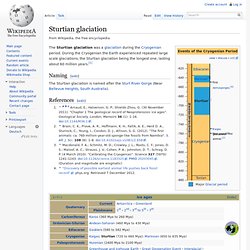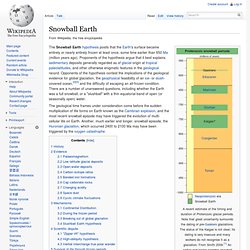

Cryogenian. The Sturtian and Marinoan glaciations,[5] which are the greatest ice ages known to have occurred on Earth, occurred during this period.

These events are the subject of much scientific controversy. The main debate contests whether these glaciations covered the entire planet (the so-called 'Snowball Earth') or if a band of open sea survived near the equator (termed 'slushball Earth'). Ratification[edit] The Cryogenian period was ratified in 1990 by the International Commission on Stratigraphy.[6] In contrast to most other time periods the beginning of the Cryogenian is not linked to a globally observable and documented event. Instead the base of the period is defined by a fixed rock age, that is set at 850 million years.[7] This is problematic as estimates of rock ages are variable and are subject to laboratory error. Climate[edit] Glaciers extended and contracted in a series of rhythmic pulses, possibly reaching as far as the equator.[8] Paleogeography[edit] Cryogenian biota and fossils[edit]
Sturtian glaciation. Events of the Cryogenian Period First sponge-like animal.[2] The Sturtian glaciation was a glaciation during the Cryogenian period.

During the Cryogenian the Earth experienced repeated large scale glaciations, the Sturtian glaciation being the longest one, lasting about 60 million years.[1] Naming[edit] The Sturtian glaciation is named after the Sturt River Gorge (Near Bellevue Heights, South Australia). References[edit] ^ Jump up to: a b c Arnaud, E.; Halverson, G. Marinoan glaciation. Neoproterozoic Snowball Periods A recent estimate of the timing and duration of Proterozoic glacial periods.

Note that great uncertainty surrounds the dating of pre-Gaskiers glaciations. The status of the Kaigas is not clear; its dating is very tentative and many researchers do not recognise it as a glaciation.[1] An earlier and longer possible snowball phase, the Huronian glaciation, is not shown here. The Marinoan glaciation was a period of worldwide glaciation that lasted from approximately 650 to 635 Ma (million years ago) during the Cryogenian period. The glaciation may have covered the entire planet, in an event called the Snowball Earth.
Origin of name and history of terminology[edit] The name is derived from the stratigraphic terminology of the Adelaide Geosyncline (Adelaide Rift Complex) in South Australia and is taken from the Adelaide suburb of Marino. Cryogenian Snowball Earth[edit] Evidence[edit] See also[edit] Snowball Earth. Proterozoic snowball periods The Snowball Earth hypothesis posits that the Earth's surface became entirely or nearly entirely frozen at least once, some time earlier than 650 Ma (million years ago).

Proponents of the hypothesis argue that it best explains sedimentary deposits generally regarded as of glacial origin at tropical paleolatitudes, and other otherwise enigmatic features in the geological record. Opponents of the hypothesis contest the implications of the geological evidence for global glaciation, the geophysical feasibility of an ice- or slush-covered ocean,[2][3] and the difficulty of escaping an all-frozen condition. There are a number of unanswered questions, including whether the Earth was a full snowball, or a "slushball" with a thin equatorial band of open (or seasonally open) water. History[edit] In 1964, the idea of global-scale glaciation reemerged when W. Interest in the snowball Earth increased dramatically after Paul F.